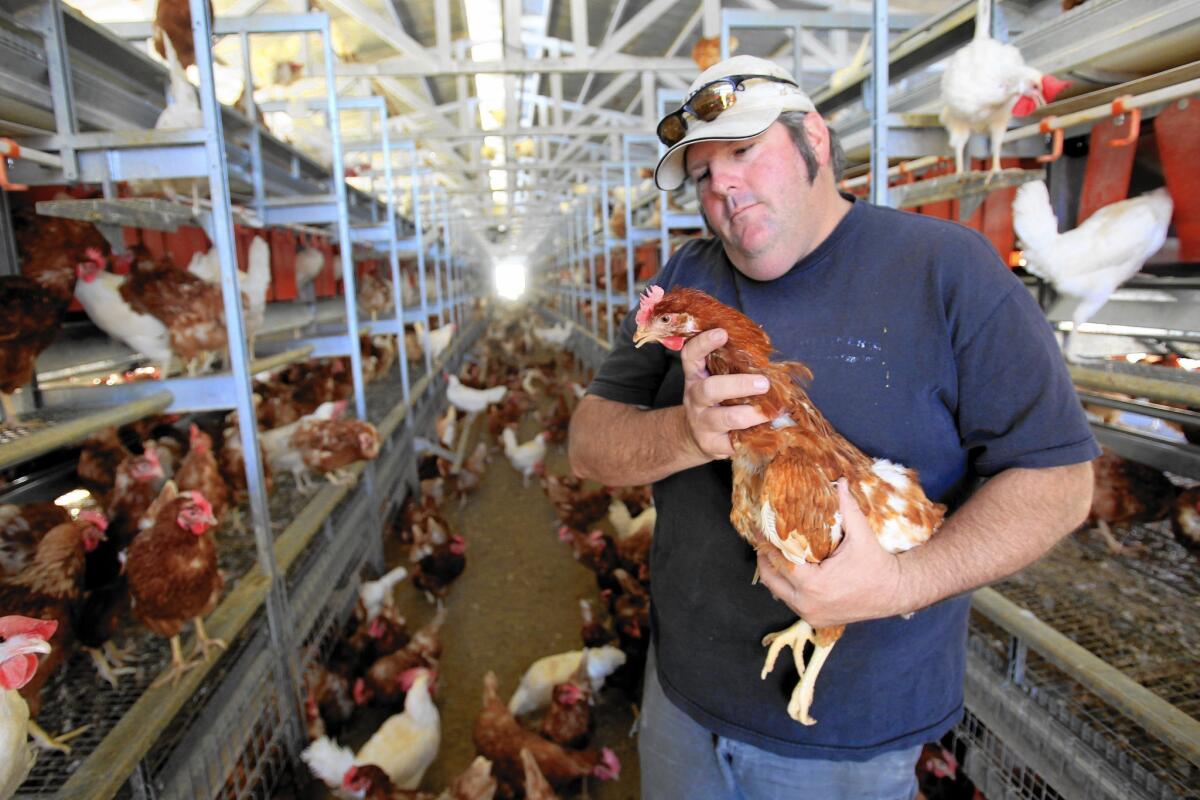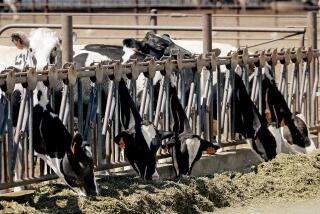Egg prices likely to rise amid laws mandating cage-free henhouses

LAKESIDE, Calif. — If your eggs seem a little pricier, consider the recent changes on Frank Hilliker’s ranch.
In the last six months, the third-generation egg farmer in central San Diego County has reduced his flock by half and embarked on a $1-million overhaul of his henhouses to make them more spacious. Customers are now paying about 50% more for a dozen eggs from Hilliker’s family business at around $3 a carton.
It’s all to comply with a landmark animal welfare law that takes effect in California on New Year’s Day. Voters overwhelmingly approved Proposition 2 in 2008 to effectively abolish the close confinement of farm animals in cramped cages and crates — a practice that animal advocates say causes needless suffering and boosts the likelihood of salmonella contamination.
------------
FOR THE RECORD:
Egg law: An article in the Dec. 29 Section A about a California law mandating cage-free henhouses said that laying hens outnumber people 2 to 1 in Iowa. The correct ratio is 20 to 1. —
------------
But to ensure the well-being of California’s 15 million laying hens, consumers will probably have to pay more for the supermarket staple. Prices for wholesale eggs are expected to rise 10% to 40% next year because of infrastructure upgrades and the reduction of flocks to provide animals more space, according to Dan Sumner, an agricultural economist at UC Davis.
Already, the specter of California’s regulations are believed to be contributing to record prices for eggs. The average wholesale cost of a dozen large eggs hit a peak of $2 on Thanksgiving Day — doubling in price from the start of November before settling this week to about $1.40. It comes at a time when soaring meat prices are expected to help push U.S. egg consumption to its highest level in seven years.
Adding to the pressure is increased demand for U.S. eggs in Canada and Mexico, where domestic poultry and egg industries are battling bouts of avian flu.
“It’s sort of a perfect storm,” said Ronald Fong, president and chief executive of the California Grocers Assn., who doesn’t expect a significant egg shortage next month, but is less clear about changes in retail prices.
California’s rules are rippling beyond its borders. No state consumes more eggs — and about a third of its supply must be imported. Iowa, where laying hens outnumber people 2 to 1, sells about 40 million eggs a day to out-of-state buyers.
Under a separate bill signed by former Gov. Arnold Schwarzenegger in 2010, all shell eggs arriving from other states must also comply with Proposition 2 by Jan. 1, 2015.
That requirement set off a barrage of lawsuits, including one from six leading egg-producing states. Missouri, Alabama, Iowa, Kentucky, Nebraska and Oklahoma invoked the constitution’s interstate commerce clause by arguing that California was interfering with their local egg industries. The suit, which was dismissed by a federal judge in October, is being appealed.
“Egg producers have had six years to come into compliance with Prop. 2, and instead of using that time to convert to cage-free systems, they’ve simply sued and sued and lost every suit they filed while sitting on their hands,” said Paul Shapiro, vice president for farm animal protection at the Humane Society of the United States, a leading proponent of California’s new animal welfare regulations.
Chad Gregory, president of the Georgia-based United Egg Producers, which represents over 90% of the nation’s egg farmers, said the industry would adapt to consumer demands — especially since other states such as Oregon, Washington, Michigan and Ohio have joined California in introducing similar laws. He hopes the federal government will eventually step in to provide uniform guidelines.
“The interstate commerce challenge is going to be a bigger problem unless we have national standards,” Gregory said.
Animal welfare groups have successfully galvanized opposition to conventional cage systems, also known as battery cages, in no small part because they are so visually objectionable.
An invention of 20th century industrial farming, the systems house tens of thousands of birds in rows of tiered, wire confinements. A typical hen spends its entire life in a roughly 8-by-8-inch space, hemmed in on all sides by other birds. Detractors say it’s cruel and conducive to injuries that lead to disease. The egg industry argues that the practice is safe, humane and essential for keeping a cornerstone of the American diet cheap and readily available.
“The sad reality is consumers don’t really know where their food comes from,” Gregory said. “What they think farming should look like is not a realistic picture if you want to provide a good and affordable source of food to 315 million people.”
Consumers are increasingly looking for alternatives to conventional eggs such as pasture-raised (hens with access to the outdoors) and cage-free (birds still in barns, but not in battery cages). Those eggs can cost two to three times as much. That hasn’t discouraged major corporations such as Burger King, Dunkin’ Donuts and Kraft Foods from pledging to invest more in cage-free eggs. Starbucks said last week it would phase out using eggs from battery cages.
Proposition 2, also known as the California Prevention of Farm Animal Cruelty Act, doesn’t explicitly call for the elimination of cages. Rather, it prohibits confinement of farm animals that doesn’t allow them to “turn around freely, lie down, stand up or fully extend their limbs.”
The Humane Society says those requirements amount to cage-free housing.
Egg farmers say they’re being guided by regulations established by the California Department of Food in Agriculture in 2013. Those rules, designed to adhere to Proposition 2, require a minimum of 116 square inches of space per bird in an enclosure — nearly double the previous standard. Hilliker, like many other farmers, has interpreted the department’s regulations as a green light to keep conventional cages as long as they meet the density requirements. But he’s still planning to retrofit his five barns so that they’re cage-free.
Eight thousand brown and white hens already roam a new 30-by-165-foot stainless-steel aviary. The noisy birds cluck, drink and eat most the day, perched on rafters or on one of three tiers that provide the animals more space. They also have access to the ground, where the birds typically like to scratch an itch.
“If there was no law, would I have done something? I don’t know,” Hilliker said.
But the 46-year-old wasn’t ready to give up a business that has been in the family since 1942. Hilliker, who runs the operation with his sister, said he owns the last remaining egg farm in a formerly agriculturally rich area a half-hour drive from downtown San Diego. Tract homes increasingly encroach on the community.
“When the law passed, we had to do some soul-searching,” said Hilliker, a stout, plain-spoken man with lean pork chop sideburns and, ironically, an aversion to breakfast. “We could have sold the land to development, become greeters at Wal-Mart and lived very comfortably.”
He resisted out of a sense of loyalty to his employees and their families. And he set out to comply with the new California rules by asking a bank for a new line of credit to pay for the retrofit.
Ever since, Hilliker has been startled by the change. Now free to move around, his hens exhibit behavior he had never seen before — like a pecking order when it comes to feeding or their playful beak-tapping on old CDs and colorful string he’s hung from the beams.
“I don’t know if the chickens know any better, but it’s made farming fun again,” Hilliker said of the new barn. “It’s a new challenge, and I feel like it has reinvigorated me.”
Twitter: @dhpierson
More to Read
Inside the business of entertainment
The Wide Shot brings you news, analysis and insights on everything from streaming wars to production — and what it all means for the future.
You may occasionally receive promotional content from the Los Angeles Times.










